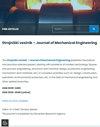Influence of Variously Modified Surface of Aluminium Alloy on the Effect of Pulsating Water Jet
IF 1.2
4区 工程技术
Q3 ENGINEERING, MECHANICAL
Strojniski Vestnik-Journal of Mechanical Engineering
Pub Date : 2017-10-10
DOI:10.5545/SV-JME.2017.4356
引用次数: 16
Abstract
Erosion effects of a pulsating water jet impinging the surface of aluminium alloy samples pre-treated by various techniques (rough and fine milling, planing and rolling) were studied. The influence of the initial surface topography on the final topography of the sample exposed to the pulsating water jet was investigated. Based on roughness parameter Ra erosion of surface layers was analysed and discussed in relation to the traversing speed of the jet. It was found that initial surface pre-treatment have a significant impact on the final topography of the surface affected subsequently by pulsating water jet. Surfaces, whose properties are significantly affected by the action of some machining processes (i.e. milling) show much greater resistance to pulsating water jet than unpaved surfaces (i.e. rolling) and surfaces have smaller roughness. While milled (rough or fine) or planed surface roughness has approximately the same increase of Ra parameter, only rolled surfaces are up to 150 times rougher after pulsating water jet treatment. This is due to the small hardening of the surface layers and reduced durability against pulsating water jet in comparison with others investigated techniques. The highest roughness was achieved on all pre-treated surfaces at the lowest speeds, because the pulsating water jet affects the surface for a longer time.铝合金表面不同改性对脉动水射流效果的影响
研究了脉冲水射流对不同工艺预处理(粗、精、刨、滚)铝合金试样表面的冲蚀作用。研究了脉冲水射流作用下试样的初始表面形貌对最终形貌的影响。在粗糙度参数的基础上,分析和讨论了表层Ra侵蚀与射流穿越速度的关系。研究发现,初始表面预处理对脉动水射流后表面形貌有显著影响。表面的性能受到某些加工过程(如铣削)的显著影响,其对脉动水射流的阻力要比未铺装的表面(如轧制)大得多,表面的粗糙度也较小。而铣削(粗的或细的)或刨削表面粗糙度的Ra参数的增加大致相同,只有轧制表面经过脉冲水射流处理后的粗糙度高达150倍。这是由于与其他研究技术相比,表面层的硬化很小,并且抗脉动水射流的耐久性降低。由于脉动水射流对表面的影响时间较长,因此在最低速度下,所有预处理表面的粗糙度都达到了最高。
本文章由计算机程序翻译,如有差异,请以英文原文为准。
求助全文
约1分钟内获得全文
求助全文
来源期刊
CiteScore
3.00
自引率
17.60%
发文量
56
审稿时长
4.1 months
期刊介绍:
The international journal publishes original and (mini)review articles covering the concepts of materials science, mechanics, kinematics, thermodynamics, energy and environment, mechatronics and robotics, fluid mechanics, tribology, cybernetics, industrial engineering and structural analysis.
The journal follows new trends and progress proven practice in the mechanical engineering and also in the closely related sciences as are electrical, civil and process engineering, medicine, microbiology, ecology, agriculture, transport systems, aviation, and others, thus creating a unique forum for interdisciplinary or multidisciplinary dialogue.

 求助内容:
求助内容: 应助结果提醒方式:
应助结果提醒方式:


